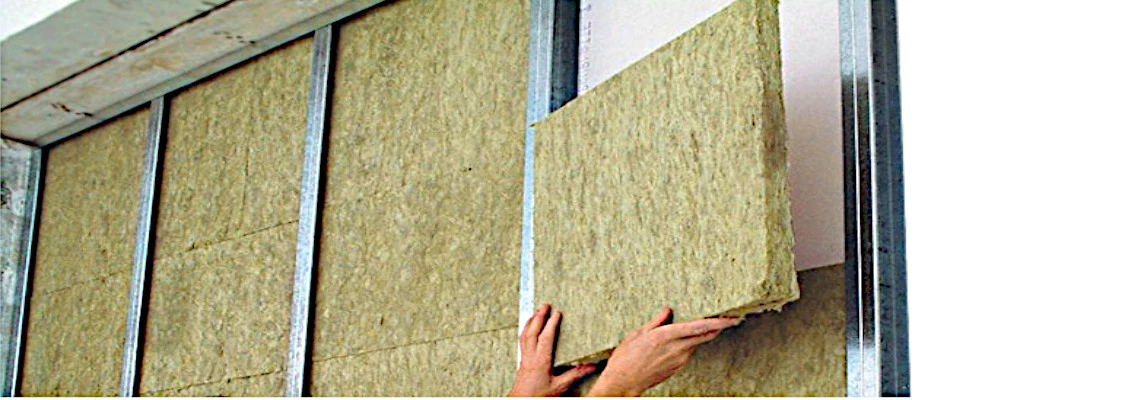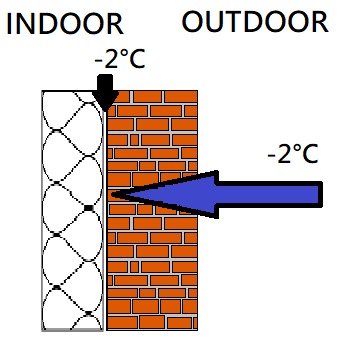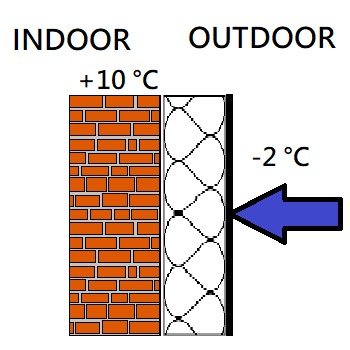
WHY YOU SHOULD NOT INSULATE WALLS INTERNALLY?*
The structural walls of a building can be insulated from both the outside and the inside. There are more proponents of insulating structural walls from the outside. Seeing that insulating the interior of a home has so many opponents, we decided to take a closer look at this topic and dispel any doubts. In this article, you will learn whether insulating walls from the inside is a good idea, what its drawbacks and advantages are, and whether it would be better to insulate walls from the outside.
IS IT BETTER TO INSULATE WALLS FROM OUTSIDE OR INSIDE?
It's true that insulating walls from the outside has always made more sense than insulating them from the inside. This is due to the different reactions that occur when insulating the structural wall.
When insulating from the outside, we shift the freezing point towards the colder side, which is the exterior (outdoors). However, when insulating from the inside, we shift this point towards the warmer side, which is the interior (the room). Why does this happen? When we insulate the wall from the inside, we lower the wall's temperature to be nearly the same as the outside temperature. In theory, they are the same.
Let's imagine a situation where we've insulated the wall from the inside. The temperature outside on a particular day is -2°C. After 2-3 days, this temperature remains the same, causing the temperature of the structural wall to drop to -2°C as well. This temperature is precisely what the interior insulation encounters, leading to condensation.

Now, let's consider the example of insulating the wall from the outside. Here we have a completely different situation. Suppose the temperature outside remains at -2°C for three days. External insulation physically separates the wall, and its temperature should almost never drop to the outside temperature of -2°C. The dew point occurs at worst at a depth of 20 mm within the insulation. As we know, this is not a problem for external insulation. External insulations are designed to handle potential moisture. Therefore, there will be no condensation on the interior walls, and the structural wall will act as a thermal buffer, capable of storing heat and later releasing it into the interior.

In summary, it must be acknowledged that it is generally better to insulate walls from the outside. Nevertheless, insulating walls from the inside is also a common practice in the UK.
IS IT BAD TO INSULATE INTERIOR WALLS?
In general, to answer this question, we must delve into physics. Physics tells us that insulating walls from the inside causes a shift in the freezing zone of the wall, and therefore, also the zone where water vapour condenses inward, potentially leading to moisture issues and reduced durability of the wall.
Considering the above, it would be reasonable to conclude that insulating walls from the inside doesn't make much sense. However, this isn't always the case, as there are many situations where insulating walls from the outside is not feasible, such as with historical homes where the preservation of external details is required.
In such a case, it cannot be said that insulating walls internally is inherently bad. Let's imagine a scenario where there is no insulation on the walls. The dew point is shifting towards the interior of our home. This leads to a situation where, sooner or later, condensation will occur at the meeting point of cold and warm temperatures. This is most likely to happen on our wall's plaster. Consequently, we may begin to deal with mould and wall moisture issues.
This is precisely the moment when considering insulating the interior walls becomes necessary. The room remains consistently cold, and the heating temperature must be set to a higher range.
What happens when we insulate the structural wall from the inside?
Insulating the walls from the inside can lead to some common issues, like reducing room space, limiting air circulation, and potentially causing persistent wall dampness due to a dew point inside the wall.
Nevertheless, insulating interior walls is not inherently bad, as long as we remember a few fundamental principles.
Firstly, the most crucial aspect of insulating walls from the inside is ensuring adequate airflow. Rooms intended for continuous human occupancy should have a minimum of 20 m³/h of outdoor air supplied for each person present. The simplest and most cost-effective solution is to create a ventilation opening with a minimum diameter of 150mm. A ventilation opening should always be installed on the side opposite to the window.
A good idea when opting to insulate interior walls is to introduce additional ventilation within the space between the insulation and the wall. This will help eliminate the likelihood of moisture forming on the structural wall.
In summary, if you don't mind a reduction in usable space, and adding extra insulation to the interior walls is not an issue, it can be concluded that insulating walls from the inside is not necessarily a bad idea. After all, it's better to have insulation than not to have it, especially if it suits your specific needs and circumstances. If you're insulating from the inside, remember to ensure additional airflow.
THE BEST INSULATION FOR INTERIOR WALLS
Let's say you've decided to insulate your interior walls, and you're on the lookout for the best insulation, preferably something that not only insulates but also finishes your walls in one go.
As of today, one of the best choices for insulating interior walls is insulated plasterboard. This compact board consists of a PIR (Polyisocyanurate) insulating core and a gypsum board bonded together under pressure. Such a product not only speeds up the work but also saves you money. We've already discussed the associated costs in the article ‘5 Benefits of Insulated Plasterboard’
Insulated plasterboard, whether with a PIR core or a phenolic board core, boasts some of the best thermal properties. For PIR core, its thermal conductivity is 0.022W/mK, while for the phenolic core, it's 0.019W/mK.
The best products for insulating interior walls are:
CHEAPEST WAY TO INSULATE INTERNAL WALLS
If purchasing insulated plasterboard is too expensive for your budget, and you're looking for a more cost-effective alternative, one option to consider is Gyproc Thermaline with a polystyrene core. Its thermal conductivity isn't as good as PIR or Phenolic core, with a value of 0.038W/mK. This means it has almost two times poorer thermal performance, so you'll need a much thicker layer to achieve the desired insulation effect.
It's worth noting that in accordance with current Building Regulations, achieving a U-value of 0.28W/m²K is required. For example, to meet this requirement, you would need to use products like Kingspan K118 with a thickness of 62.5mm.
If you still find this approach too expensive, there's another option for insulating the wall using polystyrene and finishing it with a thin coat render, similar to how you would insulate exterior walls (External Wall Insulation system-EWI). This is the most budget-friendly method available for insulating interior walls in the UK.
THE BEST THIN INSULATION FOR INTERIOR WALLS?
When insulating interior walls, it's crucial to minimise the space taken up by the insulation while maintaining excellent thermal properties. In this regard, the clear winner is Unilin's 15mm-thick product. Unilin is the only company in the UK market that guarantees a consistent 15mm thickness for every product they manufacture. This is not an easy feat, considering that the material is an PIR expanding foam, and maintaining a precise 15mm thickness can be challenging.
Therefore, when it comes to thin insulation for walls, we're talking about the 15mm Unilin product. This board doesn't break the bank, with a cost of £10 per square metre. For this price, you get a product with an outstanding thermal conductivity of approximately 0.018W/mK. Additionally, the board is coated with aluminium foil on both sides, which serves as an extra advantage by reflecting cold sources.
If you ensure the continuity of the insulation and carefully seal all board joints in 8' x 4' sheets, you can also create a sort of vapour control layer. This cost-effective solution provides both space-saving and excellent thermal performance for insulating interior walls.
4✔GOLDEN TIPS HOW TO INSULATE A COLD WALL FROM THE INSIDE?
A cold wall can significantly reduce the temperature inside a room, making it uncomfortable and causing your gas heater to work harder, consuming more energy. An effective way to reduce gas consumption and make your space warmer is by insulating the wall from the inside. While it might be a straightforward task for an experienced builder, it can be a bit daunting for someone less familiar with construction.
Here are several methods you can use to insulate a cold wall from the inside:
Insulated Plasterboard
We've extensively discussed this method in our article on "How to Install Insulated Plasterboard." You can find detailed instructions there for various installation scenarios.
Timber Frame Construction
This is a commonly used method, particularly favoured by carpenters. It involves building an independent frame structure directly against the exterior wall of your building. Insulation is then placed between the frame. The most commonly chosen insulation materials for this method are PIR board or Mineral wool, either glass or rock wool. Finally, plasterboard is attached to the frame.
Insulated Wallpaper
In this method, 10mm thick Sempatap wallpaper is used, adhered to the wall using a heavy-duty adhesive. The installation process is similar to regular wallpaper application. However, keep in mind that you may need to temporarily remove skirting boards and door architraves.
Polystyrene Insulation
This technique involves glueing 1200x600 polystyrene boards to the wall. Then, a reinforcing mesh is applied to the boards. The mesh is embedded in a layer of adhesive, followed by two additional layers of reinforcing adhesive. Once the surface is flat and prepared, you can paint it with any interior paint. This method is particularly effective for addressing wall cracks. The reinforcing mesh used in this method helps prevent further cracking on the wall's surface.
Choose the method that suits your needs and capabilities best, and you'll be on your way to a warmer and more energy-efficient space.
BREATHABLE INTERNAL INSULATION FOR SOLID WALLS
As you may know, insulating interior walls requires the implementation of additional ventilation. In many cases, it also requires highly breathable insulation to ensure solid walls can breathe properly. When it comes to providing the highest airflow for solid walls, Rockwool insulation stands out. Its structure allows for air circulation while insulating the wall at the same time. When seeking breathable insulation, it's important to avoid options like polystyrene, which has closed cell structures that impede airflow. Rigid PIR boards are not highly breathable either, especially since they are covered with aluminium foil on both sides, completely blocking air movement.
When looking for breathable insulation suitable for solid walls, consider natural materials like rock wool, hemp wool, and sheep wool.
We've covered more about these products in our article titled "Sustainable Options for Insulating Your Home."
Using breathable insulation along with proper ventilation helps maintain a healthy and well-regulated indoor environment while effectively insulating the walls.
CAN I USE INSULATION ROLL TO INSULATE SOLID WALL INTERNALLY?
As the name suggests, insulation rolls are not rigid, so they require additional support to stay in place. Insulation rolls are more commonly used for insulating horizontal surfaces like wooden floors. However, they can also be applied to walls if properly prepared. When insulating interior walls with insulation rolls, it's necessary to create a stud wall to provide a surface for attaching plasterboard and to support the sides of the insulation.
Insulating interior walls with rolls of insulation can be a budget-friendly choice, but it's not as popular because the insulation may gradually sag or lose its position over time.
CONCLUSION
When it comes to insulating interior walls, several methods and materials are available, each with its advantages and considerations. While insulating from the inside can be a practical solution to combat cold walls and improve energy efficiency, it's essential to weigh the pros and cons carefully and choose the right approach for your specific needs.
Insulated plasterboard stands out as a convenient and effective option, providing both insulation and a finished surface. However, it might not be the most budget-friendly choice for everyone.
For those seeking a cost-effective solution, Gyproc with a Styrofoam core or insulation rolls may offer savings, but they may not provide the same long-term performance or ease of installation.
For maintaining breathability in solid walls, natural insulation materials like rock wool, hemp wool, or sheep wool are recommended, allowing the walls to "breathe" while providing thermal insulation.
Additionally, when considering interior wall insulation, it's crucial to address ventilation to prevent moisture-related issues and create a comfortable living environment.
In summary, insulating interior walls can significantly improve the comfort and energy efficiency of a space, but the choice of insulation method should align with your budget, goals, and specific wall conditions. Always consult with a professional to determine the most suitable approach for your unique circumstances.
Related articles:
FOIL INSULATION: TO GAP OR NOT TO GAP? THAT IS THE QUESTION!
HOW TO PROPERLY INSTALL INSULATION BETWEEN RAFTERS: A STEP-BY-STEP GUIDE
THE PERFECT FIT: INSULATED PLASTERBOARD DIMENSIONS AND OPTIONS
COMPARING ALTERNATIVES TO CELOTEX: ROCKWOOL, KINGSPAN, EPS, AND XPS POLYSTYRENE
TOP INTERIOR WALL INSULATION PRODUCTS: A COMPREHENSIVE GUIDE
THE SOUNDPROOFING POWER OF WOOL: UNVEILING THE TOP CHOICES
INSULATION COST COMPARISON: EPS vs PIR vs MINERAL WOOL
STEP-BY-STEP GUIDE: HOW TO INSTALL CELOTEX BOARD BETWEEN FLOOR JOISTS
INSULATED PLASTERBOARD: FINDING THE SWEET SPOT FOR OPTIMAL THICKNESS
*All the information provided in the content published on Insulationgo blog is for informational and educational purposes only. Insulationgo LTD makes every effort to ensure the accuracy and timeliness of the content, but we do not assume any responsibility for any errors or omissions.
The information presented on this blog should not be considered as professional advice or a substitute for consulting relevant experts. Before making any purchase decisions or taking action based on the information presented here, it is strongly recommended to contact the product manufacturer directly to verify the details and ensure its suitability for your specific needs.
Any descriptions, drawings, photographs, data, proportions, weights, measured values etc. given herein may change without prior notice and do not constitute the agreed contractual quality of the products. It is the responsibility of the recipient of all products to ensure that any proprietary rights and existing laws and legislation are observed.
By using this blog, you acknowledge and agree that Insulationgo LTD shall not be held liable for any damages, losses, or inconveniences arising from the use or reliance on the information provided herein. This limitation of liability applies to all users of the blog, including but not limited to visitors, readers, and subscribers.










































































































